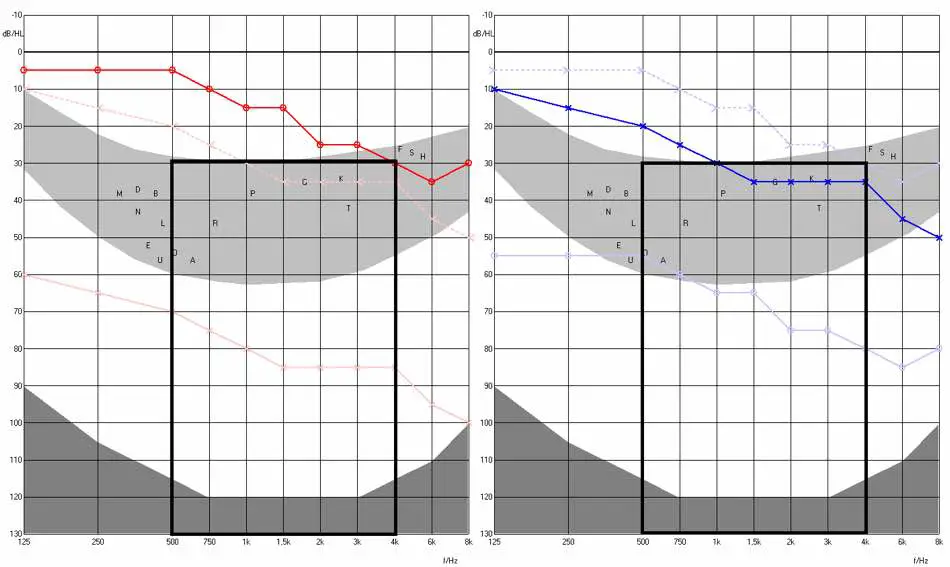In this article, you will learn about the difference between hearing aids vs hearing amplifiers. A lot of people wonder when they compare both products which may look confusingly similar.
First of all hearing amplifiers are not adjustable to your individual hearing loss. This means when you want to get the correct amplification a hearing care specialist will tune the amplification levels for a variety of frequencies to the ideal point. This is not possible with hearing amplifiers. They have general settings which you could choose from. As a result, some frequencies may receive the correct level of amplification while others do not.
For the correct fitting of hearing aids, you need to go to an audiologist because in a lot of cases a custom earmold needs to be produced to make the speech as clear as possible. In contrast with a hearing amplifier, you need to try to find the best fit of silicone domes for your ears. This DIY approach is obviously far from ideal. But hearing aid amplifiers are a lot cheaper than hearing aids.
Hearing aids often cost a couple of thousand dollars in the US while hearing aid amplifiers start at 20$. But in this article, you will learn it is not all pro hearing aids. There are a few new products in the market in the space of hearing amplifiers the hearing aid industry could learn from. Learn more in the next paragraphs.
Are Hearing Amplifiers Dangerous?
Hearing amplifiers can be dangerous to your hearing. The reason is in you can not control the volume for each frequency-independent as an audiologist can with hearing aids. This means when you hear some sounds with those devices a few frequencies might get too much amplification which could damage inner hair cells permanently.
They transform the sound vibrations in the fluids of the cochlea into electrical signals that can be heard. When they get damaged hearing loss will get more severe.
The Buying Experience of Hearing Aids vs Hearing Amplifiers
This is where hearing amplifiers shine apparently you can order them and with the marketing claims it is as easy as ordering and just using them. That of course sounds very tempting especially when you know it will probably take multiple visits at your local audiologist until your chosen hearing aids fit best. A lot of consumers wish the buying experience would be so easy. But it is not. Hearing amlifiers are simply preadjusted devices that boost the volume. But let us have a look at the picture below.

The picture above shows an audiogram for a right and left ear with a hearing loss in the higher frequencies. The lower the colored line is displayed in the picture the more amplification is needed in order to hear the sound. When you look at the colored lines first of all they are different for each ear and the needed amplification levels are differentt for each of the frequencies.
While the buying experience looks very simple with a hearing amplifier it is more like a quick fix which is potentially dangerous and you will probably need hearing aids anyway. The good thing with hearing amplifiers is you do not need to pay a premium for features like rechargeable batteries. Rechargeable batteries oftentimes bump up the price a 200-400$ compared to hearing aids with normal batteries.
When in comparison you get hearing aid amplifiers with recharchable batteries for as low as 50$. When you look for hearing amplifiers the listings are also not very clear. Because some of the hearing amplifiers are tagged with the words hearing aids so they have a better chance in appearing in the search engine or market place you use.
This is a big problem because potential buyers can get scamed easily by companies that claim to deliver you a good hearing aid when in reality all you get is a cheap amplifier. Watch the video down below and see what can happen if you buy hearing aids and hearing amplifiers on the internet.
Hearing Amplifiers vs Hearing Aids in Regards to Features
Hearing aids have features like a feedback manager which combats the whistling sound. But there is a lot more than that with hearing aids.
- Noise reduction
All hearing aids come with some level of noise reduction. - Directional microphones
Directional microphones help you to hear your conversational partner better in a noisy environment. - Telecoils
Telecoils can pick up the sounds from the hearing-aid-compatible telephone or from public induction loop systems which makes the voices clearer on phone and from the speaker in the chrurch. - Bluetooth
A lot of hearing aids are available with bluetooth. This makes streaming music directly into your ears as easy as it gets. You can even use your smartphone as a remote control. - Variable programming
Even less price intense hearing aids can store several preprogrammed settings for various listening needs and environments. All you need to do is to push a button on your hearing aid or on your smartphone app and the program switches into another setting. - Ear to ear synchronization
With ear to ear synchronization you just need to adjust the volume in one hearing aid and the volume will go up or down in both hearing aids. But is not just the volume ccontrol. Also the microphones will change settings in both ears to optimize the clearity of speech.
One of the most interesting things is as a consumer you actually do not know if what you bought fits the amplification levels you need or not. In most cases, it will not match your needs. As you saw in the picture above each ear has its unique audiogram and the adjustable settings a hearing amplifier provides are just not enough to produce satisfying results and to use it without danger to make your hearing loss worse.
